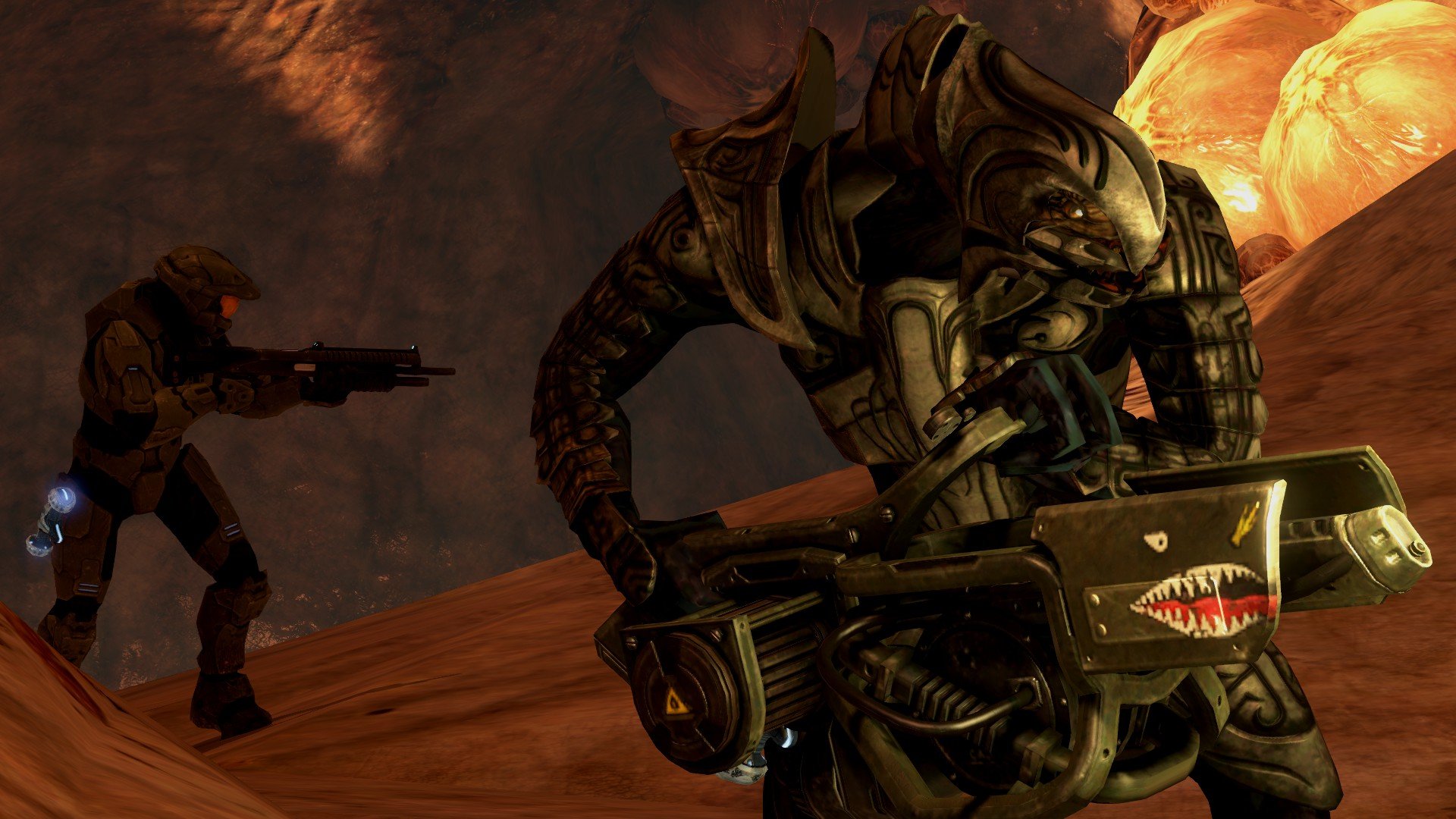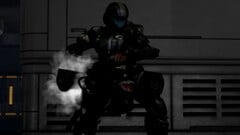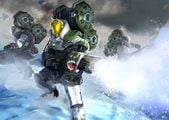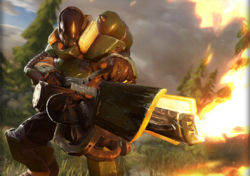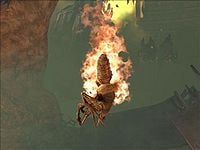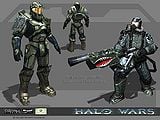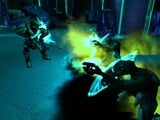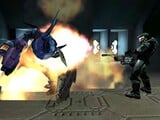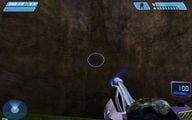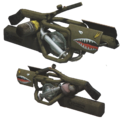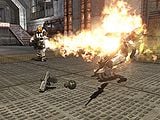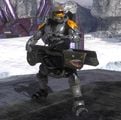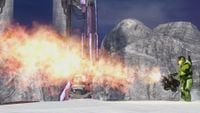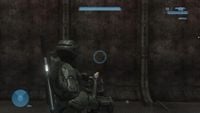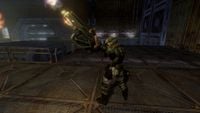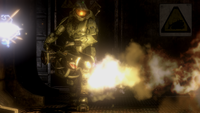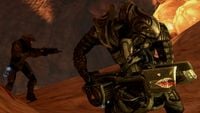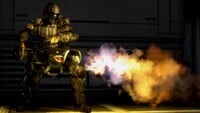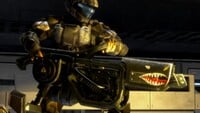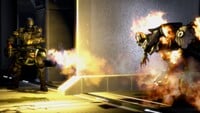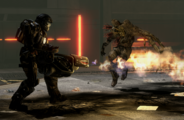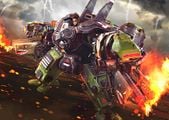M7057 flamethrower
From Halopedia, the Halo wiki
| M7057 Flamethrower | |
|---|---|
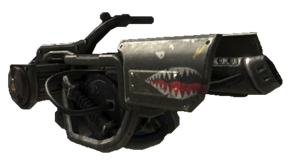
| |
| Production overview | |
|
Manufacturer: |
|
|
Type: |
|
|
Cost: |
|
| Specifications | |
|
Length: |
|
|
Weight: |
|
|
Ammunition type: |
|
|
Capacity: |
|
|
Effective range: |
13.4 meters (44 ft)[3] |
- "It takes a real lunatic to use a flamethrower..."
- — Anonymous E2-BAG/1/7 serviceman
The M7057/Defoliant Projector,[6][3][4][5] more commonly known as the M7057 flamethrower, is an incendiary weapon used primarily against battlefield fortifications, protected emplacements and installations, and for demoralization purposes. It is a variation of the NA4/Defoliant Projector.[1]
The M7057 has a number of nicknames among UNSC forces including DP, Toaster, Dragon, Torch, and Flamer.[4][5]
Overview[edit]
Design details[edit]
- "I tell 'ya, these things sure beat the old NA4 models!"
- — Anonymous Hellbringer discussing his M7057 during the Second Ark Conflict.[7]
The M7057 flamethrower is a standard chemical flamethrower, which projects and ignites a stream of a volatile, semi-liquid adhesive[6] known as Pyrosene-V. Like the M6634, the M7057 flamethrower is cumbersome and relatively difficult to tactically use (psychologically as well as mechanically).[3] In its role as a defoliant projector, it is designed to be used to rapidly clear away heavy foliage for in-theater construction projects and to destroy new or persistent growth from emplaced and/or hardened military assets.[3] For example, in 2553, Hala was able to use an M7057 unassisted to torch a Sahara-class heavy prowler.[8] Despite being all but obsolete militarily its effectiveness as a psychological weapon is undeniable—unfortunately, the psychological effect is a double-edged sword.[3]
The psychological impact of employing an M7057 makes it one in a very small number of items available to UNSC personnel that remotely earmarks the user for a full battery of psychological tests.[3] Due to the weapon's massive size and weight, it is usually deployed with a cart on which to transport it.[3] As such, UNSC Hellbringers can only use the flamethrower with the assistance of a powered exoskeleton.[9] During the Second Ark Conflict, two M7057s were fitted onto a specialised customised Cyclops employed by Lieutenant Colonel Morgan Kinsano as heavy weapons.[10]
Variants[edit]
- M705 Incendiary Jet Tool: Nicknamed the I-JeT, the M705 is a compact, vacuum-suitable variant of the M7057 fed by a tank-pack full of self-oxidizing fuel.[11]
- Cryosprayer: The cryosprayer is an experimental weapon design based on the M7057 created by Serina, the AI for UNSC Spirit of Fire. During the ship's long voyage following the Battle of Trove, Serina began to pursue cryonics research initially pioneered by professor Ellen Anders, and left the design templates for use by the CBRN specialists of the ship's Hellbringer complement.[12]
UNSC remarks[edit]
The weapon was one of many featured in Machines, Materiel and Munitions from the Human-Covenant Conflict, 2525 - Present. Several Marines of E2-BAG/1/7 were interviewed by Doctor Robert McLees, and had the following to say about the weapon.[3]
- "Foxtrots die pretty quick once you put the fire to 'em. We oughta burn 'em all. Low-life bastards. Burn all those low-life Alien Foxtrots."[3]
- "Gotta get too close for it to be any use offensively — if you're gonna use it as a weapon best to use it in a defensive role—fill up passages and weak-points in your perimeter with fire."[3]
- "Makes short work of weeds and thickets — but I wouldn't carry one into combat. Not on your life."[3]
- "I can see where it would be real effective in ousting dug in troops, but you aren't gonna be making any friends using it that way."[3]
- "I don't see why carrying around a big can of super-flammable stuff right next to my ass is such a good idea."[3]
- "You know those things ship with a cart, right? You aren't expected to carry them anywhere… they are not a weapon that you use on people...not even on alien people."[3]
- "It takes a real lunatic to use a Flamethrower..."[3]
In-game information[edit]
Halo: Combat Evolved[edit]
The flamethrower was first introduced in the Halo games with the PC release of Halo: Combat Evolved, after being cut from the original Xbox release of the game. As with the other PC port exclusive content (the M12A Rocket Warthog and the Zasqi-pattern fuel rod gun), it is included in the Combat Evolved multiplayer component of Halo: The Master Chief Collection.
Due to the weapon's history, it can only be used in multiplayer, and appears as a default spawn on several multiplayer maps. It can be equipped and used in first-person view as with all other weapons in the game, and supports the player throwing grenades with it equipped or using it to melee. The weapon's range is similar to the shotgun, which is only effective at close-quarters. When fired within range, the flamethrower deals lethal damage to unshielded opponents. Against shielded opponents, it will remove their shields and apply a substantial amount of damage to the opponent's health.
Through use of the Halo Editing Kit for Halo Custom Edition and The Master Chief Collection, Flood combat forms are able to wield the flamethrower. The only way to observe this is to play start a "Heavy Slayer" game on a map that spawns Combat forms. The Combat form will hold it upwards, making the weapon useless in their hands since the fire will go upwards without hurting anyone in front of the form. The reason why the flamethrower is compatible with Combat forms is because the flamethrower was supposed to appear in the level Keyes, and Bungie programmed Combat forms to be able to carry it in order to grant the player easier accessibility. The player was then to use an acquired flamethrower to burn Captain Keyes' skull from the Proto-Gravemind in order to retrieve his neural implants.[13]
In Halo: Combat Evolved, the flamethrower shares the same reticule with the Shotgun and the Sniper Rifle. In Halo: The Master Chief Collection, the reticule for the flamethrower in Halo: Combat Evolved has been updated to match the flamethrower reticule from Halo 3.
Halo 3 and Halo 3: ODST[edit]
After being cut from Combat Evolved, the flamethrower was redesigned for inclusion in Halo 2 though also cut from that game. It once again debuted in Halo 3, this time as one of the newly-added turrets in a similar manner to the Machine Gun Turret, Missile Pod, and Pek-pattern plasma cannon. Players wielding the weapon move at a slower pace and from a third-person perspective. Moreover, they cannot melee or use any of their grenades or equipment. Unlike the other turret weapons, the flamethrower has no mounted variation, meaning that flamethrower is no longer useful once the fuel has been depleted - however, it operates in a manner similar to energy weapons in that it will overheat if fired for too long. The flamethrower's screen effects are capable of blinding the player in a manner similar to the Flare equipment.
The weapon appears in the campaign levels Floodgate and Cortana, both levels featuring the Flood as primary enemies. This alludes to the weapon's most useful function - clearing swarms of densely-packed enemies such as pod infectors. Flood pure forms will die nearly instantly upon lighting on fire, and any pod infectors that run into the flames are immediately killed. Though still highly effective against Flood combat forms, they still live for some time while on fire. It can also be used to destroy a pile of Combat Forms, so they won't come back if a Pod infector finds them. It is also very handy to handle Flood carrier forms, as lighting it on fire can cause the Pod infectors not to disperse upon death.
Even though UNSC Marines claim that their comrades wield the flamethrower, the player can not give it to them in game. The only time when a Marine is seen wielding one is in the level Floodgate; it is seen being used inside the factory, (the spot where any surviving Marines hold position) holding it like Master Chief. One needs to be in Theater mode or playing on a lower difficulty to see the Marine holding it, because he dies in a few seconds.
In multiplayer, the flamethrower only appears on the map Construct by default, situated at the bottom of the map. It is one of two weapons capable of granting an Incineration medal when used (the other being the Firebomb Grenade), and is also capable of easily granting a Kill from the Grave medal.
The weapon reappears in Halo 3: ODST, and works identically to its Halo 3 counterpart. It appears only on the level Data Hive, and can be useful in clearing out swarms of Drones while traversing the hive. If fired at Vergil, it will immediately kill the Engineer regardless of difficulty - resulting in a mission fail. The flamethrower cannot be used in Firefight with default settings or in the original Xbox 360 release. However, the updated Floodfight mode and custom settings in the game's Master Chief Collection port does allow for this.
In Halo 3: ODST, there is one achievement that can be unlocked with the flamethrower.
| Icon (Xbox 360) | Name | Description | Gamerscore |
|---|---|---|---|

|
I Like Fire | Kill 10 enemies with the Flamethrower on Data Hive. | 5 |
Production notes[edit]
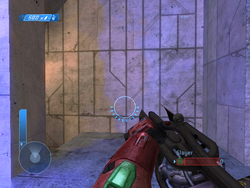
- Main articles: Cut Halo: Combat Evolved weapons, Cut Halo 2 weapons
The flamethrower has a storied history as cut content in the Halo games. The weapon is one of many originally designed for inclusion in Halo: Combat Evolved, and went through a number of design iterations in this time.
In the cutscene of the Halo: Combat Evolved level Keyes, where the Master Chief retrieves Captain Jacob Keyes' neural implants, the Master Chief was meant to burn Keyes' skull out of the Proto-Gravemind and retrieve the implants. Unfortunately, due to time constraints, the Flamethrower was removed. Lorraine McLees was the one who actually had to texture the whole "burnt" skull and she added that she had done her job so well that "the skull was so gruesome no one could look at it."[13]
The weapon was redesigned for inclusion in Halo 2, and was even featured in the game's beta stages alongside a Covenant counterpart - the Disintegrator.[14] However, the design was reused for an art piece included in the Halo Graphic Novel gallery, depicting Maria-062 holding the weapon.
The M7057 was later modelled by Gene Kohler for inclusion in Halo Wars as a weapon for use by the Hellbringers. However, the weapon was cut and replaced by the NA4 flamethrower for unknown reasons.
Trivia[edit]
References[edit]
- The weapon's designation is a reference the TOZT .25 and TOZT-7 flamethrowers from Bungie's Marathon trilogy. "TOZT" and "7057" (the latter a leetspeak rendering of the former) are both plays on the word "toast".
- The shark-like decal on the M7057's heat shroud is inspired by the Curtiss P-40 Warhawk fighter-bomber made famous by the Flying Tigers (First American Volunteer Group) during the Second World War. Aircraft of the 23rd Fighter Group, the Flying Tigers' modern successor, continue the use of the shark teeth decoration.
- The Dragon's Breath rocket launcher from Bungie's later Destiny series uses a similar muzzle decoration.
- In Halo: Combat Evolved, when a Spartan wields a flamethrower, they flip back a cover to expose a button. Next to the button is the Chinese character 下 or 'xia' (meaning "down").
Gallery[edit]

|
Browse more images in this article's gallery page. |
A Halo: Combat Evolved promotional screenshot depicting Master Chief using the flamethrower against Jackals on The Truth and Reconciliation.
A Halo: Combat Evolved promotional screenshot depicting Master Chief using the flamethrower against a Hunter on The Silent Cartographer.
Maria-062 with the cut Halo 2 flamethrower design in the Halo: Graphic Novel.
The flamethrower on Snowbound.
The HUD reticule of the M7057/Defoliant Projector as seen in the Halo 3 campaign level Floodgate. Note that the camera focuses outward in a third-person view, similar to the view when wielding a heavy turret.
An ODST using the flamethrower in Floodfight.
M7057s mounted on a custom Cyclops piloted by Morgan Kinsano.
List of appearances[edit]
- Halo: Combat Evolved (Halo: The Master Chief Collection-only)
- Halo: Combat Evolved for PC (First appearance)
- Halo Graphic Novel
- Halo 3
- Halo 3: ODST
- Halo Wars 2
- Halo: Silent Storm
- Halo: Lone Wolf
- Halo: Divine Wind (Mentioned only)
Notes[edit]
- ^ The original Bungie reveal for the flamethrower referenced its length as being 116.8cm (46in) - this inconsistency has only included in one other source: the 2009 Halo Encyclopedia. The Encyclopedia's 2011 reprint changed the length stat to the one displayed on this page - something which has been consistently used since.
Sources[edit]
- ^ a b c d Halo: The Essential Visual Guide, page 69
- ^ a b Halo Encyclopedia (2022 edition), page 172
- ^ a b c d e f g h i j k l m n o p q r s t u Bungie.net, The Flamethrower (Retrieved on Jan 31, 2021) [local archive] [external archive]
- ^ a b c d e f Halo Encyclopedia (2009 edition), page 311
- ^ a b c d e f Halo Encyclopedia (2011 edition), page 325
- ^ a b Halo: Combat Evolved for PC Manual, page 13
- ^ YouTube - jungle_penguins, Halo Wars 2: UNSC Hellbringer All Quotes: 0:35 "I tell 'ya, these things sure beat the old NA4 models!" - Hellbringer ambient dialogue
- ^ Halo: Lone Wolf, issue 2
- ^ YouTube - jungle_penguins, Halo Wars 2: UNSC Hellbringer All Quotes: 0:39 "I feel like a tank in this thing! Does your exo chafe? Mine chafes." - Hellbringer ambient dialogue
- ^ Halo Wars 2, Kinsano's Cyclops in-game unit
- ^ Halo: Silent Storm, chapter 10
- ^ Halo Wars 2, Phoenix Logs: Cryotrooper
- ^ a b The Art of Halo, page 140
- ^ Twitter, The Vengeful 'Vadam (@vengeful_vadam): "In the Halo 2 Beta, there were two cut weapons: -The Flamethrower, which would be repurposed to become the Halo 3 Flamethrower -The Disintegrator, a Covenant counterpart to the Flamethrower." (Retrieved on Sep 8, 2021) [archive]
| |||||||||||||||||||||||||||||||||||||||
